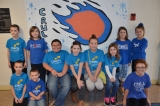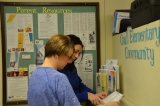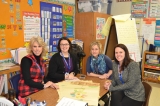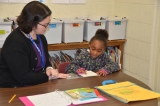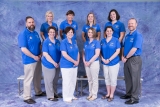-
Category 2
Selected in 2016
-
Grades: pre k - 5
School Setting: suburban
Town Population: 29,330
Student Enrollment: 432
Student Demographics:
Black/African American: 7.9%
Teacher/Student Ratio: 1:18.8
White/Caucasian: 77.8%
Hispanic: 4.4%
Hawaiian/Pacific Islander: 0%
Asian: 0.2%
Native American: 0.2%
Other: 9%
% Reduced Lunch: 100%
% ELL Learners: 0.9%
Founded: 1965 -
PRINCIPAL:
Charles Raski -
CONTACT:
2720 Riverside Drive
Port Huron, MI 48060
810-984-3101
dtuczek@phasd.us
H D Crull Elementary School
Port Huron, MI
We are ALL responsible for the learning and achievement of ALL children.
- Describe specific programs in place to ensure that families are involved in the success of your school and students.
- We have a Title I Parent Involvement Facilitator (PIF). The role of the PIF is to improve and sustain a school-family partnership that breaks down the barriers that often times turn families off from engaging with school. For example, we have a significant truancy issue and we know that attendance is crucial so each day our PIF connects with both absent students and their families. She often provides them with community resources, food, clothing, or transportation assistance options. In addition, we invite families to use our school’s technology resources and internet. In this setting our PIF provides whatever assistance they may need. Many times she helps parents access our Student Information System and demonstrates how they can monitor their child’s academic progress. We have found the PIF to be an effective use of Title I family engagement funds. We are providing support that is targeted, ongoing throughout the school year and most importantly, we are building relationships.
- Describe the most successful activity your school has initiated to strengthen ties to your community.
- We believe the most successful activity is our “Crull Comet Community Gatherings” They are held twice a month on Friday morning. Our Parent Teacher Association is a huge supporter of our Gatherings and they encourage family attendance at the events. During the all school Gatherings we recognize student academic achievement, citizenship, promote positive relationships, celebrate traditions, successes, and embrace talents of students and staff as entire learning community. Students and families look forward to attending these communal cultural shaping opportunities. Our Gatherings set the tone for positive climate and culture throughout the school.
- Describe your philosophy of school change or improvement.
- Change often starts with recognizing insanity: “Doing the same thing over and over and expecting different results.” Ownership and accountability starts at the top. The building leader must communicate and model high expectations for the school team. Change often comes from crucial conversations about teaching and learning and by truly digging into the data and being honest about what’s working and what’s not. Rarely does change or school improvement start with everyone but it does start with those leaders within the staff who have the willingness and the courage to step out of their comfort zone in the best interests of the students. With the necessary support and the green light from their administrators, these “game changers” can lead others to the desired change especially when we see the positive results of their efforts. Improvement is the result of the innovative, creative, bold, and hardworking staff willing to meet all students wherever they are and move them forward.
- What are your school’s top two goals for the next year?
-
Our first goal is to keep students, staff, and families safe and well informed by strengthening our PBIS system. Our PBIS Team has worked to develop a common language for this practice building wide. We concentrate a great deal on the significance of serving our families and the community with open arms, without reservation, without judgment. This must feel sincere. We achieve this by a collective mindset that we have chosen a profession that allows us opportunities to truly change the lives of every individual we make contact with in a positive way on a daily basis. Our staff works collaboratively to provide an orderly, peaceful, and welcoming climate for learning. We model lifelong learning because we believe we are still learners.
Our second goal is to increase the capacity of our staff to learn from each other by evaluating the teaching and learning initiatives and strategies being implemented in our school. We will accomplish this through our Grade Level Team meetings.
- What is the single most important factor in the success of your school that others could replicate?
- We believe the most important factor in our success, is our commitment to effective and efficient weekly Grade Level Team (GLT) meetings. It can be said that time is the greatest gift we can give our staff. By ensuring that GLT meeting time is held sacred we have been able to build trusting relationships within the staff. This has truly transformed the culture of our school into a place where everyone wants to be. The GLT meetings are more than just planning out the next week’s lessons or talking about projects and field trips. Each GLT meets to discuss the outcomes on student assessments and then plans how to best reach students that are underperforming, while also challenging students that need extensions. At Crull we go out of our way to work together and concentrate on what we can control: teaching and learning at school. Our teachers feel like they can and that they are making a difference for each of our students.
- Describe the program or initiative that has had the greatest positive effect on student achievement, including closing achievement or opportunity gaps, if applicable.
- We believe our commitment to MTSS Implementation has had the greatest effect on student achievement. Our mindset is that all students can and will learn. Effective Tier I core content instruction is the number one determining factor for student success. Our teachers are going deeper with curriculum implementation focused on maintaining fidelity with our core programs and using best instructional practices. We also have a daily intervention block for ELA and math. During this time teachers provide Tier II interventions to flexible small groups of students within the classroom. We have specific Tier III interventions for both reading and math provided by Title I funded staff. Students in need of Tier III support are identified and monitored through the Student Support Team (SST) process. The SST process includes ongoing data collection and the development of Action Plans/Intervention Log. Student data is reviewed by the SST every 6-8 weeks.
- Explain how Title I funds are used to support your improvement efforts.
-
To increase the effectiveness of Tier I instruction, Title I provides Instructional & Behavior Coaches. Building staff capacity supports us in closing the achievement gap. We also have a Title I Parent Involvement Facilitator who engages families as partners in helping students succeed. In addition, Title I provides Reading Recovery Teachers, an Intervention Specialist, an Instructional Paraprofessional and a Behavior Interventionist. Our Reading Recovery teachers teach Reading Recovery for a half of day and split a general fund 2nd grade classroom. This model has proven effective because our 2nd grade students receive the benefits of a highly trained Reading Recovery teacher in the general education classroom. Our Intervention Specialist and Instructional Paraprofessional provide Tier III reading and math support using Leveled Literacy Intervention and DELTA Math. These students are achieving tremendous gains as reflected in NWEA & standardized M-STEP assessments.
- Identify the critical professional development activities you use to improve teaching and student learning.
- Two of the most critical professional developments activities that make a significant impact on improving teaching and student learning are our Grade Level Team (GLT) meetings and instructional coaching. Each GLT meets weekly to analyze the outcomes on student assessments and then plan how to best reach students that are underperforming, while also challenging students that need extensions. The GLT time is sacred because it allows staff to dive into the “how” and “why” of their students’ achievement and provides a collaborative time for staff to learn from each other The Instructional Coaching is ongoing guidance for teachers on how to go deeper with curriculum implementation and is focused on maintaining fidelity with our core instructional programs. Teachers are learning how to be facilitators of learning, talking less, and setting a foundation for student led learning and discussion. Our professional development is authentic and meets the needs of teachers “in real time”.
- Describe how data is used to improve student achievement and inform decision making.
- Once a week during our Grade Level Team meetings, we use the Lipton and Wellman data protocol which guides us through collaborative data dialogues and problem solving. Instructional planning is based on data that is gathered through NWEA Testing, classroom summative and formative assessments, progress monitoring, daily instruction, surveys, and perception data. We are planning, pacing, and instructing using the same strategies, together. Some grade level teaching teams are now sharing students and differentiating small group instruction across the grade level based on the data shared during the team dialogues. We have whole team staff meetings twice a month and we focus time on reviewing building wide data. Our philosophy is that we are ALL responsible for the learning and achievement of ALL children. Our teaching teams build on each other’s strengths and lift each other up in areas of needed improvements.
- Describe your school culture and explain changes you’ve taken to improve it.
- A “culture of collaboration” best describes Crull. We have achieved this by establishing PLCs, Positive Behavior Intervention Support (PBIS), and community engagement. Through our weekly Grade Level Team meetings, teachers have built trusting relationships and have crucial conversations around teaching and learning. Teachers take responsibility for their own learning and this translates to accountability for student achievement. We also recognize teachers for student successes. Through our implementation of PBIS, we are able to maintain a safe, peaceful environment for learning where staff, students, and families feel welcome and enjoy coming every day. This is achieved by a philosophy we embrace: “Doing the small things that make a big difference.” To expand our community engagement we hold “Crull Comet Community Gatherings”. As an entire learning community, we recognize student academic achievement, citizenship, celebrate traditions, and embrace talents of students and staff.
Stats
-
Category 2
Selected in 2016
-
Grades: pre k - 5
School Setting: suburban
Town Population: 29,330
Student Enrollment: 432
Student Demographics:
Black/African American: 7.9%
Teacher/Student Ratio: 1:18.8
White/Caucasian: 77.8%
Hispanic: 4.4%
Hawaiian/Pacific Islander: 0%
Asian: 0.2%
Native American: 0.2%
Other: 9%
% Reduced Lunch: 100%
% ELL Learners: 0.9%
Founded: 1965 -
PRINCIPAL:
Charles Raski -
CONTACT:
2720 Riverside Drive
Port Huron, MI 48060
810-984-3101
dtuczek@phasd.us


